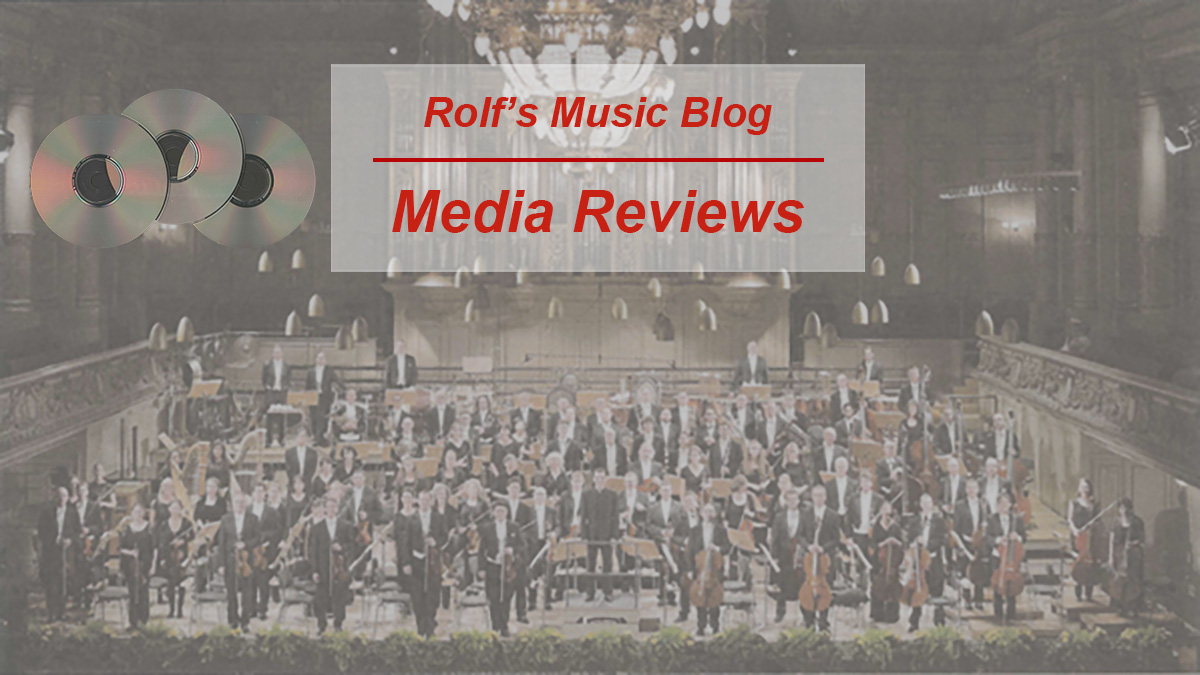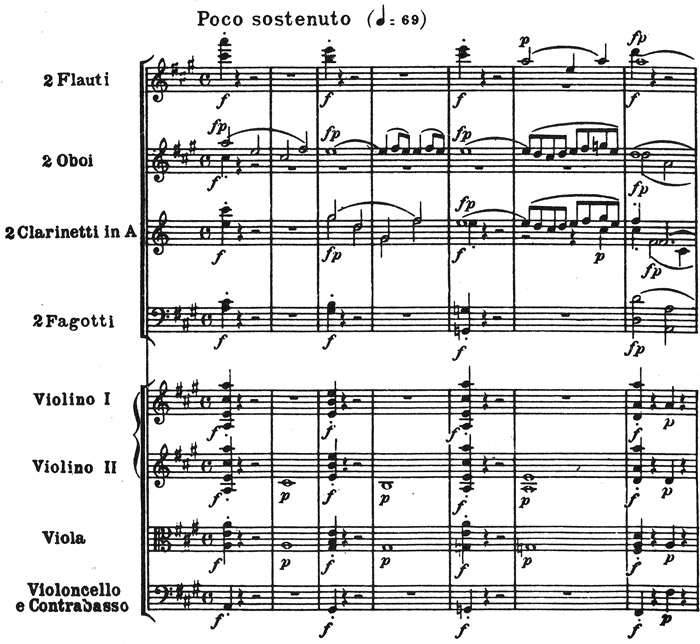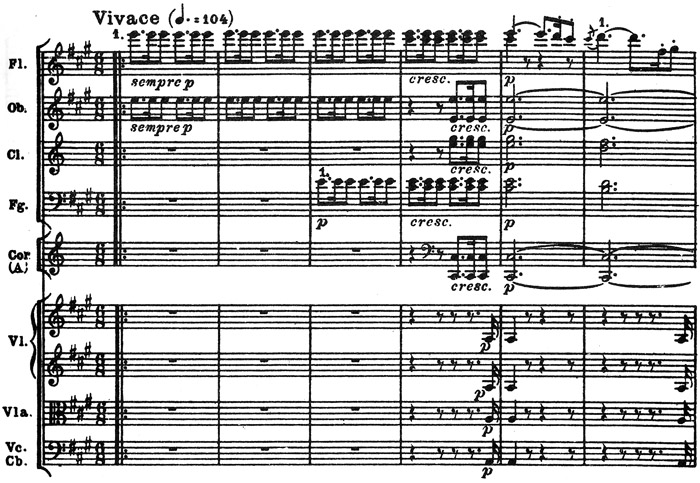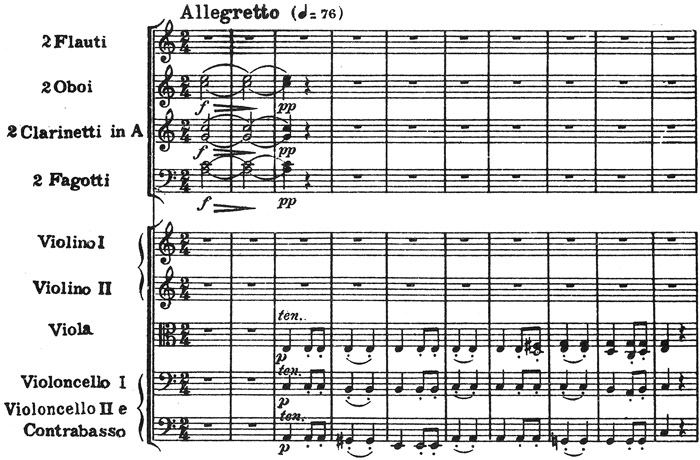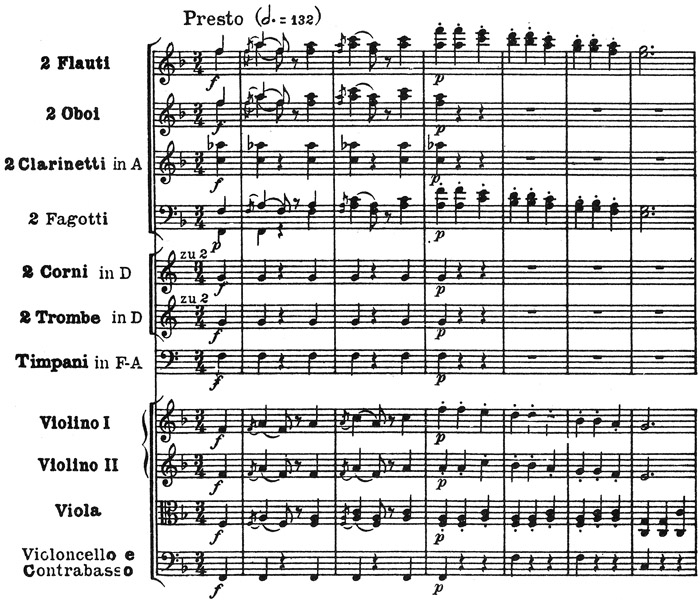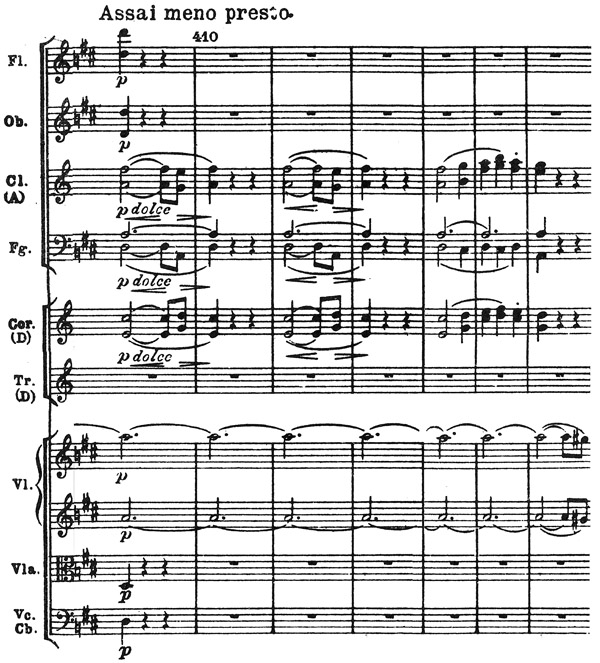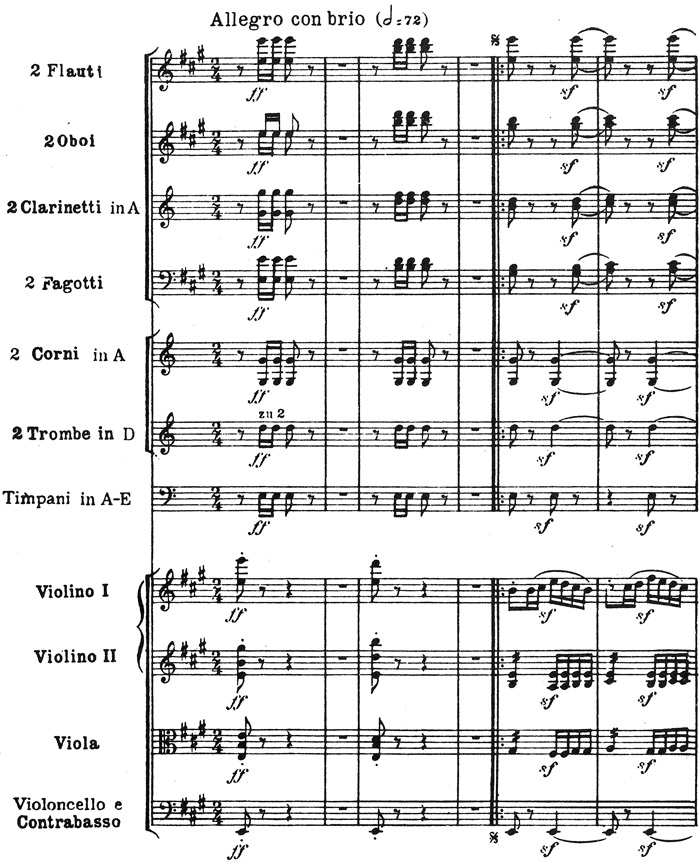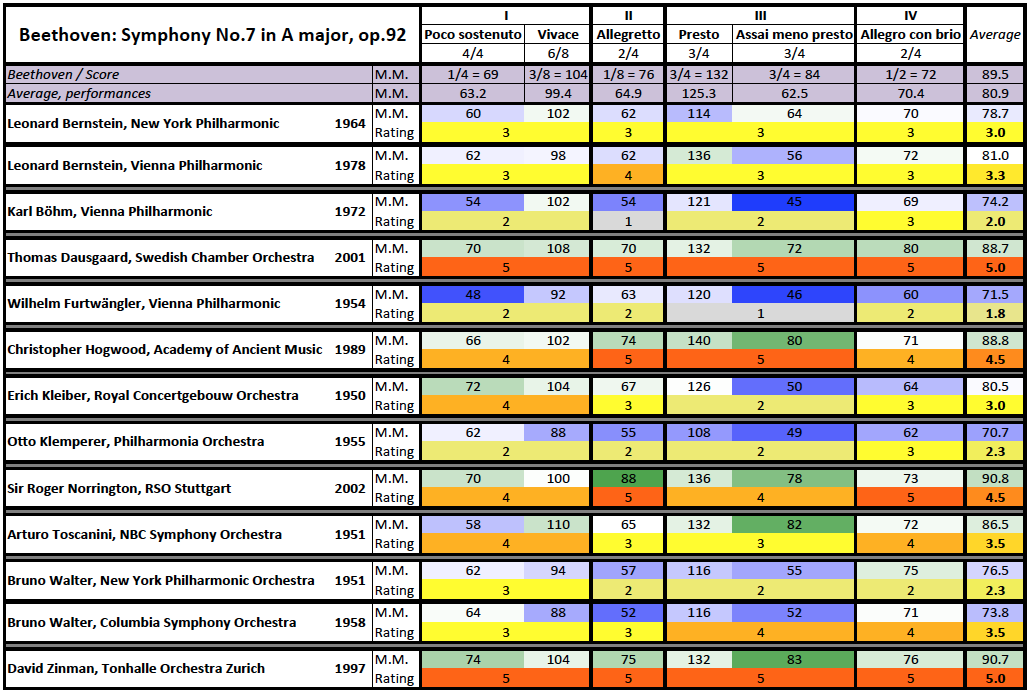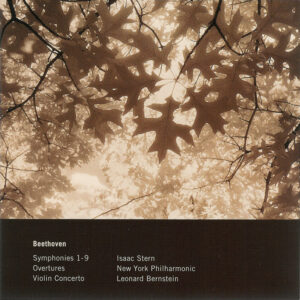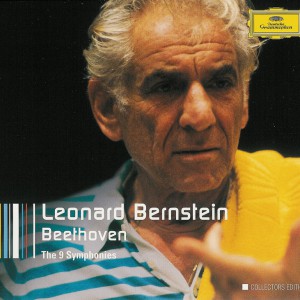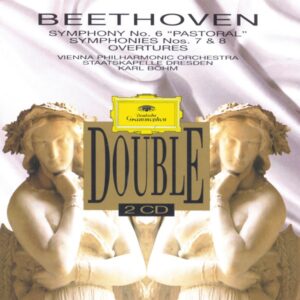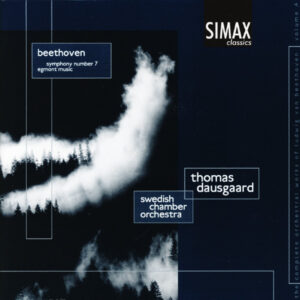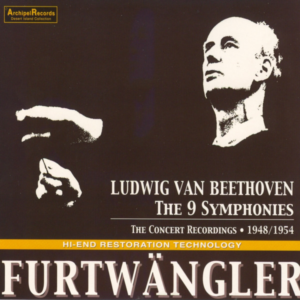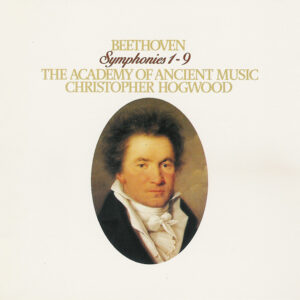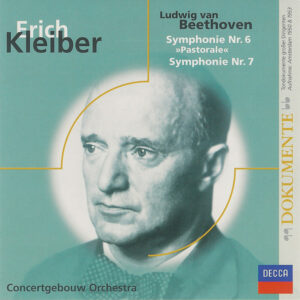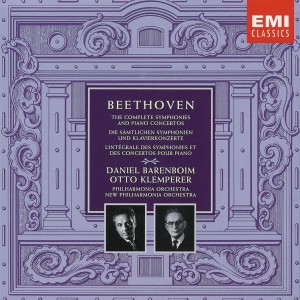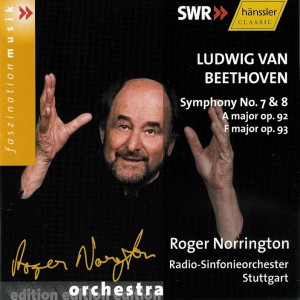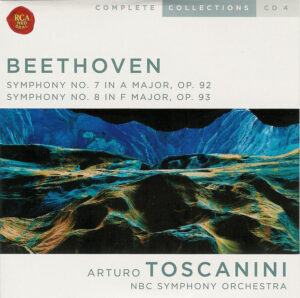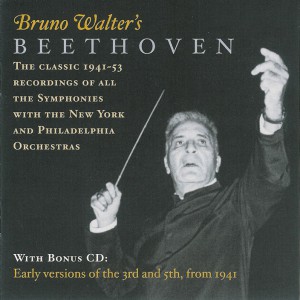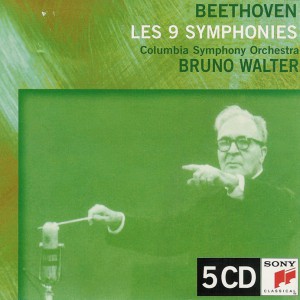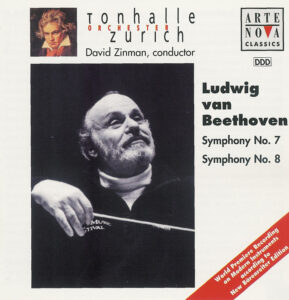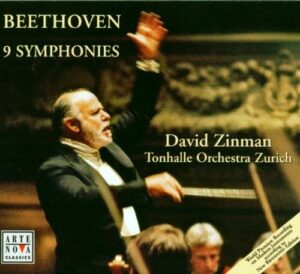Ludwig van Beethoven
Symphony No.7 in A major, op.92
Media Review / Comparison
2015-08-21 — Original posting
2016-08-06 — Brushed up for better readability
Table of Contents
- Introduction / The Recordings
- Background, About the Composition:
- The Interpretations, Overview
- The Interpretations, Detail
- Leonard Bernstein , New York Philharmonic Orchestra (1964)
- Leonard Bernstein , Vienna Philharmonic (1978)
- Karl Böhm , Vienna Philharmonic (1972)
- Thomas Dausgaard , Swedish Chamber Orchestra Örebro (2001)
- Wilhelm Furtwängler , Vienna Philharmonic (1954)
- Christopher Hogwood , The Academy of Ancient Music (1989)
- Erich Kleiber , Royal Concertgebouw Orchestra (1950)
- Otto Klemperer , Philharmonia Orchestra (1955)
- Sir Roger Norrington , Radio-Sinfonieorchester Stuttgart (2002)
- Arturo Toscanini , NBC Symphony Orchestra (1951)
- Bruno Walter , New York Philharmonic Orchestra (1951)
- Bruno Walter , Columbia Symphony Orchestra (1958)
- David Zinman , Tonhalle Orchestra Zurich (1997)
- Addendum 1
- Addendum 2
Introduction / The Recordings
This posting is about Ludwig van Beethoven’s Symphony No.7 in A major, op.92, of which I currently have 13 recordings. Most of the older ones — up to and including Bernstein with the Vienna Philharmonics — are also present in my LP collection. The last four were added more recently, in order also to have current interpretations for comparison. The recordings in chronological sequence:
- Erich Kleiber, Royal Concertgebouw Orchestra (1950)
- Arturo Toscanini, NBC Symphony Orchestra (1951)
- Bruno Walter, New York Philharmonic Orchestra (1951)
- Wilhelm Furtwängler, Vienna Philharmonic (1954)
- Otto Klemperer, Philharmonia Orchestra (1955)
- Bruno Walter, Columbia Symphony Orchestra (1958)
- Leonard Bernstein, New York Philharmonic Orchestra (1964)
- Karl Böhm, Vienna Philharmonic (1972)
- Leonard Bernstein, Vienna Philharmonic (1978)
- Christopher Hogwood, The Academy of Ancient Music (1989)
- David Zinman, Tonhalle Orchestra Zurich (1997)
- Thomas Dausgaard, Swedish Chamber Orchestra Örebro (2001)
- Sir Roger Norrington, Radio-Sinfonieorchester Stuttgart (2002)
In the discussion below, I deal with the recordings in alphabetic order. My listening sequence is neither alphabetic nor chronological.
A General Note on These Comparisons
Before starting, let me re-iterate on something that I stated in a posting on my digital music collection — I have what I have, and this is primarily driven by two things:
- I try preserving the music that I had on LPs — and in the LP days, I strictly followed my curiosity rather than trying to collect “everything”
- Since I started collecting CDs, I also tried selectively adding newer recordings that fit my current interests (i.e., typically historically informed performances, of recordings of current artists that caught my interest).
No Karajan??
One response to my review of Beethoven’s Symphony No.3 (“Eroica”) was “Not a single version of Karajan’s recordings? You’ve got to be kidding…” — no, I kid you not! I never was a particular fan of Karajan, but I haven’t completely ignored him (OK, I do, for the Beethoven symphonies): I know his qualities, such as his quest for the perfect sound, his ability to engage with the very best soloists available — but I also have come across some of his limitations, if not deficiencies, at least from today’s perspective (I’ll get to those once I discuss the relevant recordings). For sure, his recordings are not competitive in an environment (and a personal preference) that favors historically informed interpretations (for, say, classical music up to the early romantic period).
Unless I have special ties to a particular interpretation (e.g., from the LP days) or artist (e.g., from past concert experiences), I typically refuse to add recordings of which I know that they will fall off against my favorites: criticizing recordings that I don’t like is not a purpose of my blog, and I can’t even dream of covering “all” relevant artists. There are instances where I’m trying to be comprehensive, e.g., when I’m collecting all of Beethoven’s piano sonatas played by a given (selected) artist, but never by trying to collect all recordings of a given piece (note also that the amount of work — time and effort — grows with the number of recordings involved in a comparison). Hence, my comparisons will always be fragmentary.
Background, About the Composition:
Ludwig van Beethoven (1770 – 1827) wrote his Symphony No.7 in A major, op.92, in 1811/12. The composition was published only in 1816, and Beethoven added the metronome numbers in 1817 (together with those for symphonies No.1 – 6 and No.8).
The Movements:
I. Poco sostenuto, 4/4 (1/4 = 69) — Vivace, 6/8 (3/8 = 104)
450 bars
The first movement starts with an introduction of 62 bars, annotated Poco sostenuto — traditionally, this was played substantially below Beethoven’s metronome mark, and rather Maestoso, if not Pomposo:
The following Vivace part is a regular sonata form, with repeat signs around the exposition (114 bars) — most of the traditional recordings (Furtwängler, Walter, Toscanini, Erich Kleiber, Klemperer, Böhm) ignore the repeat signs; this may be mandated by the maximum duration on early recording media; more likely it is the tradition from the late 19th century — which again is likely a consequence of the slow tempo imposed by that tradition. The exposition does not directly start with the main theme, but with a lead-in in punctuated 6/8 rhythm, played by the wind section:
The first flute then introduces the main theme, which also uses that punctuated motif in the first bar:
The movement ends with a 50-bar Coda.
II. Allegretto, 2/4 (1/4 = 76)
278 bars
From the annotations, this symphony doesn’t feature a really slow movement — in absolute terms: the second movement is slower than the other ones, though; it is annotated Allegretto:
But in the tradition of the late 19th / early 20th century, this movement appears to have mutated into a slow piece, whereby the composer’s metronome annotation was largely ignored. Sure, it is unusual to find an Allegretto in this place — but this annotation does not imply a “fast” movement, and newer recordings demonstrate that Beethoven’s metronome mark does indeed make sense!
III. Presto, 3/4 (3/4 = 132) — Assai meno presto, 3/4 (3/4 = 84)
653 bars
Even without explicit annotation, the next movement is a Scherzo, in 3/4, but Presto, very fast and virtuosic:
As in a typical Scherzo, there is a Trio-like segment — actually two of them in this symphony, annotated Assai meno presto (shown here: the beginning of the second instance):
The overall structure of the movement can be seen as follows (parentheses around bar counts indicate repeats):
- Presto: (24) + (124) bars
- Assai meno presto: 32 + (42) + 14 bars
- Presto: 172 bars
- Assai meno presto: 32 + (42) + 14 bars
- Presto: 144 bars
- Coda — Presto: 4 bars — Assai meno presto: 4 bars — Presto: 4 bars
The older, traditional recordings just perform the initial repeat (24 bars), Toscanini also did the repeat in the first Assai meno presto segment; Bernstein added the second repeat in the initial Presto to this; only newer recordings (Hogwood and later) perform all four repeats in the score. I have added some remarks about the importance of repeats at the end of this post, under Addendum 2.
IV. Allegro con brio, 2/4 (1/2 = 72)
465 bars
The strongly rhythmic dance character in the last movement has received enthusiastic comments — it sure was the reason for Richard Wagner (1813 – 1883) calling this symphony an “apotheosis of the dance”: fittingly, the movement is annotated Allegro con brio, with a metronome rate of 72 bars (2/4) per minute:
This has been described as a sonata form movement (parentheses around bar counts indicate repeats):
- Exposition: ( 4 + (8) + (8) + 100 )
- Development: 4 + 22 + (8) + (8) + 58
- Recapitulation and Coda: 4 + (8) + 234 bars
At a first glance, the form seems unusual (formally, the evolution part appears to resemble a recap section, whereas the recap section doesn’t follow the scheme of the exposition) — but that’s just the “bookkeeper’s aspect”: the main theme consists of two repeated segments of 8 bars, except for the recap section, which just has one group of 8 repeated bars. the 8-bar repeats are observed by all conductors, everywhere in this comparison — the older / traditional recordings don’t repeat the exposition.
The Interpretations, Overview
In order to provide a rating overview, as well as an idea about tempo relations both within an interpretation, as well as between the two recordings, I have prepared the little table below. Note that the color coding for the tempo (blue = slower, green = faster) refers to the average between the recordings, not to the metronome markings in the score (as the latter would have made just about everybody look slow!). Note that the metronome rates were measured near the beginning of the movements and therefore are not representative for cases with a strongly accelerating tempo:
The ratings should be clear (1 = lowest/gray, 3 = yellow, 5 = highest/orange-red) — these are meant to be my personal opinion and relative, not absolute.
The Interpretations, Detail
As mentioned above, I’m discussing the interpretations in alphabetic order (by the conductor’s last name) — note, however, that this is not the order in which I did the comparison: in the listening order, I try grouping similar recordings together, also typically listening to slower performances prior to faster ones, as I feel that this is the best way to do justice to every recording. Keep in mind that even if I make lots of critical comments to a given recording, this does not imply that I didn’t enjoy the music — even though I can’t deny that I’m in favor of historically informed performances: many of the older recordings definitely retain their historic value, and most of them are still interesting to listen to!
Leonard Bernstein, New York Philharmonic Orchestra (1964)
Beethoven: Symphonies 1 – 9, Overtures, Violin Concerto
Leonard Bernstein, New York Philharmonic Orchestra
Isaac Stern
Sony Classical SB6K 87885 (6 CDs, stereo); ℗ 1959 – 1970 / © 2002
Booklet: track listing only

This is from the earlier cycle of stereo recordings of all Beethoven symphonies that Leonard Bernstein (1918 – 1990) made with the New York Philharmonic Orchestra. Bernstein recorded the Symphony No.7 in 1964.
Orchestra arrangement: Vl 1 — Vl 2 — Vla — Vc
Notes on the Movements
I. Poco sostenuto, 4/4 — Vivace, 6/8
Duration: 14’33”
Compared to the more recent recording below, the initial f (tutti) chords are rather hard, inelastic. The coordination in the semiquaver scales is not as good as with the Vienna Philharmonics, and overall, the introduction often sounds a bit loud — and overall, the sound (recording) is not very differentiated, sometimes a bit coarse, the woodwind sound not very favorable. On the bright(er) side, the tempo is a tad faster (closer to Beethoven’s annotation) than in the later recording, feels more like a proper Vivace. But also in this earlier recording, Bernstein focused on rhythm and momentum, rather than details in the articulation / phrasing.
II. Allegretto, 2/4
Duration: 9’07”
Slow, but consequent in the tempo; often fairly broad in the articulation, sometimes rather heavy.
III. Presto, 3/4 — Assai meno presto, 3/4
Duration: 9’29”, last repeat not done
In the Presto, Bernstein here is among the slowest — this is Allegro at most, but well-played otherwise, maybe a bit too much “big orchestra” overall. The Assai meno presto parts are substantially slower than annotated, but faster than most traditional interpretations. The articulation is often a bit coarse, if not even (sometimes) harsh, “military”.
IV. Allegro con brio, 2/4
Duration: 9’04”
To me, the sound of a typical American orchestra — excellent discipline / coordination, often loud, the articulation rather hard (almost “military” at times), inelastic. In this earlier recording, Bernstein uses more rubato than later in Vienna. On the positive side: the exposition is repeated.
Overall Duration: 42’12“
Rating (see above for details): 3.0 — This has a hard time competing with today’s HIP recordings.
Leonard Bernstein, Vienna Philharmonic (1978)
Beethoven: Symphonies 1 – 9
Leonard Bernstein, Vienna Philharmonic
DG 474 924-2 (5 CDs, stereo); ℗ 1980/2004 / © 1981
Booklet: 24 pp. en/de/fr

This is the more recent complete recording of all Beethoven symphonies by Leonard Bernstein (1918 – 1990), this time with the Vienna Philharmonics. Bernstein made this second recording of the Symphony No.7 in 1978.
Orchestra arrangement: Vl 1 — Vl 2 — Vla — Vc
Notes on the Movements
I. Poco sostenuto, 4/4 — Vivace, 6/8
Duration: 14’17”
A solid, conventional interpretation — clearly with a big, (post-)romantic orchestra, the articulation not as light as is preferred today (sometimes a bit too legato). The tempo is OK, the second (main) part doesn’t always feel Vivace, but has momentum, is internally consistent, fairly compelling as a traditional performance: vivid, rhythmic pieces are certainly Bernstein’s strength. The articulation could sometimes be more detailed: with the focus on rhythm & drive, some motivic work / articulation is occasionally a bit superficial.
II. Allegretto, 2/4
Duration: 8’48”
Same base tempo as the older recording (gradually, but consequently accelerating later) — but much, much better string sound (and orchestra sound in general), more differentiated in the articulation. It may be too slow, but Bernstein keeps pulling forward, across the movement, reaching around 1/4 = 72 (fairly close to Beethoven’s tempo!), only slightly slowing down for the final part. One of the better conventional interpretations, even though the accelerando at times feels slightly “fabricated”.
III. Presto, 3/4 — Assai meno presto, 3/4
Duration: 9’00”, last repeat not done
An interesting evolution between Bernstein’s two recordings— here, the Presto is faster than Beethoven’s annotation, as fast as the fastest HIP recordings! On the other hand, the Assai meno presto has become slower! In the fast parts, the tempo is at a point where details start to get lost (at least for the listener), and Bernstein (to me) focuses a bit too much on momentum and rhythm, at the expense of differentiation in phrasing and articulation.
IV. Allegro con brio, 2/4
Duration: 7’11”, exposition not repeated
Good tempo, but often stomping, just loud & boisterous, lacking lightness in articulation, dynamic differentiation. Strangely, the exposition is not repeated — it was repeated in the earlier recording.
Overall Duration: 39’15“
Rating (see above for details): 3.3 — I expected more.
Karl Böhm, Vienna Philharmonic (1972)
Beethoven: Symphonies No.6 – 8; Overture to Fidelio, op.72; Overture No.3 to “Leonore”, op.72a
Karl Böhm, Vienna Philharmonic
DG / iTunes download (CD, stereo, 256 kbps); ℗ 1993
Booklet: none with download

Karl Böhm (1894 – 1981) recorded the Symphony No.7 in 1972, as part of a complete cycle, with the Vienna Philharmonic Orchestra — for more information see the post “Beethoven: Symphony No.4 in B♭, op.60“.
Orchestra arrangement: Vl 1 — Vl 2 — Vc — Vla
Notes on the Movements
I. Poco sostenuto, 4/4 — Vivace, 6/8
Duration: 12’19”, exposition not repeated
The intro is slow, broad, too forceful in the sforzati; the coordination within the strings is OK, but less than perfect between strings and wind instruments. Strangely, most rising scales in the strings appear to accelerate — because they are taken as crescendo?? The Vivace part is in good tempo, but has a tendency to be loud, ff — too big an orchestra sound from today’s perspective, lacking elasticity.
II. Allegretto, 2/4
Duration: 9’57”
Too slow, definitely (see Bruno Walter’s recordings), also lacking contours: just broad, largely very legato, streaming — boring.
III. Presto, 3/4 — Assai meno presto, 3/4
Duration: 8’29”, only the very first repeat is done
The Presto isn’t all that slow, the playing OK, nothing exciting, though — sometimes losing momentum a bit. Unfortunately, the Assai meno presto is totally static and extremely slow: Beethoven’s Metronome rates indicate a slow-down by around 1/3 — Böhm slows down almost two-thirds! Böhm’s tempi are virtually identical to Furtwängler’s.
IV. Allegro con brio, 2/4
Duration: 7’06”, exposition not repeated
A classic, tradition al interpretation, luckily not as heavy as the truly romantic ones!
Overall Duration: 37’50“
Rating (see above for details): 2.0 — A traditional performance, in my view with some flaws; there are more interesting interpretations from that time, and in this tradition.
Thomas Dausgaard, Swedish Chamber Orchestra Örebro (2001)
Beethoven: Symphony No.7 in A major, op.92; Music to “Egmont”, op.84
Thomas Dausgaard, Swedish Chamber Orchestra Örebro
Henriette Bonde-Hansen, soprano
Simax classics/ iTunes download (CD, stereo, 256 kbps); ℗ 2001
Booklet: none with download

Since 1997, Thomas Dausgaard (*1963) is the principal conductor of the Swedish Chamber Orchestra in Örebro. For more information see the post “Beethoven: Symphony No.4 in B♭, op.60“. Dausgaard recorded the Symphony No.7 in 2001.
Orchestra arrangement Vl 1 — Vla — Vc — Vl 2
Notes on the Movements
I. Poco sostenuto, 4/4 — Vivace, 6/8
Duration: 13’39”
In terms of acoustics, quality of string sound, smoothness, etc., this recording can’t compete with David Zinman’s recording — but it sure brings a smaller orchestra (more realistic for the orchestra at Beethoven’s time), more authenticity in terms of string sound, overall balance and lightness in the articulation. The goal is not a polished, perfect recording, but a more “realistic” sound experience — and the playing is definitely excellent.
Dausgaard closely follows Beethoven’s tempo annotations (i.e., the metronome rates); compared to Zinman, the dynamic span is smaller (mainly due to the smaller orchestra), the sf / staccato chords are short and concise, but not exceedingly dry or hard. The tempo in the Vivace is a little faster than Beethoven’s annotation, maybe at the upper limit — but still mastered very well, without feeling pushed / exceedingly driven. I love the horn sound, as well as that of the woodwinds! The music feels real lively and expressive — a joy to listen to.
II. Allegretto, 2/4
Duration: 7’49”
Initially, Dausgaard is slightly below Hogwood’s (and Beethoven’s) tempo, but still reasonably close, the playing is relaxed, yet alert, transparent; over the course of the first part, Dausgaard reaches the annotated tempo, through a very subtle accelerando (less obvious than Bernstein, for sure): working with a small body of string instruments is so much better and easier on this piece. Really excellent, overall!
III. Presto, 3/4 — Assai meno presto, 3/4
Duration: 8’40”, with all repeats
In the Presto, the tempo follows Beethoven’s annotation spot-on: virtuosic, transparent, playful, light — excellent interpretation, but not as polished as Zinman’s. Compared to the annotation, the Assai meno presto is a little slow — but with wonderful tonal qualities, almost like chamber music in the p section, with wonderful woodwind and brass voices — marvelous!
IV. Allegro con brio, 2/4
Duration: 8’17”
With 1/2 = 80, Dausgaard has the fastest base tempo in this comparison — faster than the composer’s annotation; the orchestra masters that extremely well, maintaining excellent coordination — the advantage of a small, but virtuosic orchestra! The articulation is light, the transparency excellent (better than Hogwood’s recording, also in dynamic balance); the playing is not overly polished or sterile, nor exceedingly boisterous, but vivid, joyful, compelling, maintaining or even building up momentum (and some extra tempo!) up to a really enthralling ending!
Overall Duration: 38’23“
Rating (see above for details): 5.0 — Clearly my favorite, along with Zinman’s recording!
Wilhelm Furtwängler, Vienna Philharmonic (1954)
Beethoven: Symphonies 1 – 9
Wilhelm Furtwängler, Vienna Philharmonic
Berlin Philharmonic, Philharmonia Orchestra, SDR Symphony Orchestra
live recordings 1948 – 1954
IMD Music Distribution Ltd. ARPCD 0214 (5 CDs, mono); ℗ / © 2004
Booklet: track listing only

This is from a collection of live concert recordings that Wilhelm Furtwängler (1886 – 1954) made 1948 – 1954, with various orchestras; the Symphony No.7 was recorded with the Vienna Philharmonic in 1954 — this is a live recording with noises from the audience, and with occasional intonation issues (and with the occasional portamento in the violins, which now appears superfluous). The recording technique of course has limitations, especially in the transparency: it is an early stereo recording, but the spatial resolution / differentiation is severely limited (e.g., I can’t tell for sure whether the second violins were placed on the right or not).
Notes on the Movements
I. Poco sostenuto, 4/4 — Vivace, 6/8
Duration: 13’40”, exposition not repeated
As one would expect, Furtwängler is far away from Beethoven’s metronome marks, the melody presented by the woodwinds in the first bars is extremely slow, hardly perceived as a melody, particularly in a live situation (and this is a live recording). To me, this is not Poco sostenuto, but it feels Lento, also in the way in which ornaments are played, and the heavy accents / sforzati in the strings appear to proclaim “grandiose! heavy! solemn! etc.”; I think this is far away from Beethoven’s intent.
The transition to the Vivace is harmonic, Furtwängler (after considerable rubato) reaches a tempo (1/4 = ca. 46) at the end of the introduction, at which 1/8 corresponds to 3/8 in the Vivace. That second part can be called Vivace, though the articulation is fairly heavy and often massive, such that some of the sforzati are hardly felt as such. Some of the pp interjections (e.g., bar 156) are mf at least.
II. Allegretto, 2/4
Duration: 9’38”
Not quite as slow as Walter / Böhm, but still heavy and too slow, not Allegretto; Furtwängler creates big arches, but the articulation is not very differentiated. The central A major part is slower (1/4 = 59), and also the last part is slowing down noticeably; it’s hard to enjoy this recording, considering the recent changes towards Beethoven’s metronome marks!
III. Presto, 3/4 — Assai meno presto, 3/4
Duration: 8’21”, only the very first repeat is done
The tempo in the Presto is below the score, but still acceptable — however, the articulation in the strings is anything but clean, often superficial, with just moderate coordination (OK, this is a live recording — but then, it’s the Vienna Philharmonics!). The Assai meno presto is clearly the slowest in this comparison — Beethoven specifies slowing down by approx. 1/3 — this is a slow-down to 1/3!! these slow parts are totally static, sometimes overblown (not from a romantic perspective, but certainly looking back from today’s HIP practice!). Not Furtwängler’s best recording, I’m afraid!
IV. Allegro con brio, 2/4
Duration: 7’37”, exposition not repeated
The beginning (first theme) sounds rather heavy, the articulation superficial, the coordination not perfect (but again, it’s a live concert recording). The second theme (after the repeats) is noticeably faster, there is a fair amount of rubato throughout the movement, with a strong accelerando at the end. Not really competitive with more recent recordings in terms of orchestral qualities, but certainly a typical Furtwängler interpretation — one can picture him forming those big build-ups / waves — not sure the orchestra is able to realize all of his ideas, his overall plan!
Overall Duration: 39’14“
Rating (see above for details): 1.8 — A romantic, historic landmark, maybe — but so far from what we now consider historically correct & appropriate…
Christopher Hogwood, The Academy of Ancient Music (1989)
Beethoven: Symphonies 1 – 9, Overtures to “Coriolan” and “Egmont”
Christopher Hogwood, The Academy of Ancient Music
Decca / L’Oiseau-Lyre 425 z696-2 (6 CDs, stereo); ℗ 1986 – 89 / © 1989
Booklet: 90 pp. en/fr/de/it

Christopher Hogwood (1941 – 2014) made this recording of all Beethoven symphonies with the Academy of Ancient Music between 1983 and 1989 — Symphony No.3 was recorded in 1989. For more information see the post “Beethoven: Symphony No.4 in B♭, op.60“.
Orchestra arrangement: Vl 1 — Vla — Vc — Vl 2
Notes on the Movements
I. Poco sostenuto, 4/4 — Vivace, 6/8
Duration: 14’21”
Clearly a historically informed performance, very obvious in a comparison, be it only because of the lower pitch (a’ = 430 rather than a’ = 440 – 442) and the softer, warmer sound, e.g., in the oboes & flutes (it’s also interesting to see that with period instruments, the sound balance is often more on the oboes than on the flutes when they play in parallel!).
Especially the sound is a very pleasant change (also in the overall balance) from the traditional recordings: this is supposed to be Poco sostenuto, not Maestoso! The tempo is fairly close to Beethoven’s annotations, also in the Vivace. The only downside in my view is an occasional, slight lack of tempo control in short phrases, and maybe the overall coordination & rhythmic precision in the Vivace part (not quite matching up to that of other orchestras), maybe linked to a slight lack of transparency & clarity.
II. Allegretto, 2/4
Duration: 7’35”
Ah — what a difference it makes if this movement starts close to Beethoven’s annotated metronome number: no need to push or accelerate (like Kleiber, Toscanini, and Bernstein), the tempo is fluent, yet, the movement remains relatively calm. In the A major part, Hogwood takes a very slightly faster tempo, fitting the more forward-looking character of that section. The playing throughout the orchestra is light, transparent, never harsh — and the coordination is excellent: a very good recording!
III. Presto, 3/4 — Assai meno presto, 3/4
Duration: 8’03”, with all repeats
In the Presto, Hogwood is considerably faster than Beethoven’s annotation — yet, the orchestra manages this amazingly well; not with extroverted, polished / cold virtuosity, but with “natural” agility and avoiding harsh articulation, and the movement never feels rushed / pushed! The Assai meno presto comes without Norrington’s refined dynamics, but instead, one gets to enjoy the natural balance between strings and woodwinds, and the warm, soft tone / articulation of the woodwind instruments.
IV. Allegro con brio, 2/4
Duration: 9’15”
I like the orchestra sound, i.e., the sound of period instruments — but sadly, this movement doesn’t fully play out the strengths of a HIP performance — e.g., the movement lacks some dynamic differentiation: it sounds as if Hogwood aimed at exposing as many secondary voices as possible (indeed, there are voices — especially in the horn and other wind instruments — which are usually not heard by themselves, which are now — somewhat — highlighted, catching the listener’s attention) — hereby losing the focus on the primary melody, and the distinction between melody voice and accompaniment. Also, some sforzati (especially in the main theme, in the strings) could be more pronounced. The tempo is very good, but the recording of this movement is not entirely convincing.
Overall Duration: 39’14“
Rating (see above for details): 4.5 — A pioneering HIP recording, and a landmark as such; excellent, but not top in all movements.
Erich Kleiber, Royal Concertgebouw Orchestra (1950)
Beethoven: Symphonies 6 & 7
Erich Kleiber, Royal Concertgebouw Orchestra
Decca 476 762-2 (CD, mono); ℗ 1951, 1954
Booklet: 20 pp. en/fr/de

Erich Kleiber (1890 – 1956) was mainly known as an opera conductor, but he did leave behind some fine orchestral recordings, too, such as this one with two Beethoven symphonies. Erich Kleiber recorded the Symphony No.7 in 1950.
Notes on the Movements
I. Poco sostenuto, 4/4 — Vivace, 6/8
Duration: 10’52”, exposition not repeated
In the intro, Kleiber is even a little faster than Beethoven’s metronome mark! It’s very well-played in general — in the semiquaver scales it sometimes appears a little fast / pushed, no longer sostenuto — even though the tempo in crotchets is OK: maybe it should be slightly lighter in the articulation? In the Vivace, the tempo is exactly as specified by the composer (sometimes even faster!), with lots of drive & momentum — though sometimes it appears a bit pushed, causing superficialities — maybe too fast for such a big orchestra? Still, a strong interpretation with a clear concept!
II. Allegretto, 2/4
Duration: 7’39”
The beginning is quite remarkable in its dynamic differentiation (slight accents on the non-staccato crotchets) and one of the fastest tempi among the traditional / conventional interpretations. The starting tempo still is below Beethoven’s annotation, but Kleiber is clearly pushing for faster tempo, adding accelerandi, and probably coming close to the annotated metronome number — unfortunately, this approach isn’t very successful in this recording, as it leads to considerable unrest through major parts of the movement. Also, in the more vivid A major part and (particularly) in the last section (a minor), the coordination in the orchestra is quite poor.
III. Presto, 3/4 — Assai meno presto, 3/4
Duration: 7’27”, only the very first repeat is done
Among the legacy recordings, this is one of the fastest interpretations: only Toscanini is faster in the Presto. Kleiber’s Presto is joyful, sparkling, lively. The Assai meno presto is very slow, almost at Klemperer’s tempo — a vast contrast to the fast parts — more than Beethoven could possibly have intended. These slow parts are very static, and the large tempo contrast causes coordination and superficial articulation in the second and third Presto segments. Too bad also about all the omitted repeats — would be nice to hear the movement in Beethoven’s original proportions!
IV. Allegro con brio, 2/4
Duration: 7’34”, exposition not repeated
The first theme is maybe on the slow side (1/2 = 64), the articulation a bit harsh, “military” — but then, for the second theme, Kleiber accelerates to 1/2 = 77 — substantially faster, if not rather fast. This tempo change — consequent across the movement — is the most prominent sign of Zeitgeist in this movement; but the playing is clear, clean, fairly transparent
Overall Duration: 33’30“
Rating (see above for details): 3.0 — An impressive historic recording, and one of the better traditional interpretations, with an excellent conductor, paying attention to clear articulation.
Otto Klemperer, Philharmonia Orchestra (1955)
Beethoven: The Complete Symphonies and Piano Concertos; Choral Fantasia; Great Fugue op.133; Overtures Leonore 1-3, Coriolan, Prometheus
Otto Klemperer, Philharmonia Orchestra, Daniel Barenboim
EMI 5 73895 2 (9 CDs, stereo); ℗ / © 2000

This is part of the complete cycle of Beethoven symphonies (later also including the piano concertos, with Daniel Barenboim and the New Philharmonia Orchestra) that Otto Klemperer (1885 – 1973) realized in the late fifties, with the Philharmonia Orchestra; Klemperer recorded the Symphony No.7 in 1955. For more information see the post “Beethoven: Symphony No.4 in B♭, op.60“.
Orchestra arrangement: Vl 1 — Vc — Vla — Vl 2
Notes on the Movements
I. Poco sostenuto, 4/4 — Vivace, 6/8
Duration: 12’52”, exposition not repeated
The intro has a better tempo than Furtwängler’s, is less pomposo. The precision / coordination of the strings isn’t very good (e.g., in those semiquaver scales with the two violins in unison or in parallels) — this exemplifies the downside of the arrangement with opposing violin groups. In quaver and crotchet passages that are not annotated staccato, the strings are too legato & soft from today’s perspective. The Vivace has a tendency to be heavy, to exhibit the power of the big, romantic orchestra, and the tempo is on the slow side.
II. Allegretto, 2/4
Duration: 9’32”
About as slow as Bruno Walter; maybe less detailed in the articulation (and the coordination in the orchestra is not always perfect), but forming impressive, long & dramatic phrases and build-ups. In contrast to Furtwängler, Klemperer takes the A major part noticeably faster, at around 1/4 = 65.
III. Presto, 3/4 — Assai meno presto, 3/4
Duration: 8’22”, only the very first repeat is done
Klemperer delivers a solid, somewhat (too?) handsome interpretation — unfortunately at a tempo that is far from the composer’s annotation: the Presto parts are Allegro at best (just barely joyful). The difference to Beethoven’s tempo annotation is even bigger in the Assai meno presto: in line with the romantic tradition, this appears an almost complete standstill, in extreme contrast to the Presto parts. The playing in the orchestra is fine — but that tempo is not a challenge, of course.
IV. Allegro con brio, 2/4
Duration: 8’01”, exposition not repeated
Rather heavy, on the slower side, but nevertheless a strong, clear interpretation, without excessive romanticisms — what I miss most is a bit more brio.
Overall Duration: 38’48“
Rating (see above for details): 2.3 — A bit handsome, often heavy, but still a strong, traditional interpretation.
Sir Roger Norrington, Radio-Sinfonieorchester Stuttgart (2002)
Beethoven: Symphonies 1 – 9, Introductions by Sir Roger Norrington
Sir Roger Norrington, Radio-Sinfonieorchester Stuttgart
Hänssler Classics (5 CDs + Bonus CD, stereo); ℗ 2000 / © 2000
Booklet: 17 pp. de/en (this CD)

Sir Roger Norrington (*1934) recorded Symphony No.7 with the Radio-Sinfonieorchester Stuttgart in 2002, from live concerts. For more information see the post “Beethoven: Symphony No.4 in B♭, op.60“.
Orchestra arrangement: Vl 1 — Vla — Vc — Vl 2
Notes on the Movements
I. Poco sostenuto, 4/4 — Vivace, 6/8
Duration: 13’38”
Norrington is frequently quoting Beethoven’s metronome numbers as important criteria for historically correct performances — and in this movement he is very close to Beethoven’s annotations.
The orchestra plays with modern instrument, but orchestral arrangement, size and articulation all reflect the criteria for HIP playing. The orchestra is pretty good at that — the one hair in the soup in the introduction might be occasional, slight coordination issues between the two (opposed) violin groups, a potential drawback of this arrangement, especially with bigger orchestras — but then, this is a live recording, and so, perfection cannot be the most important criterion. In the Vivace part, there are some superficialities in the articulation that (I think) cannot just be attributed to the live recording situation — more likely to limitations in the orchestra.
II. Allegretto, 2/4
Duration: 6’39”
In his introduction, Norrington point out the importance of Beethoven’s tempo annotation, and the validity of the composer’s metronome values. Well, here now (in a live concert, though), he clearly is above the composer’s annotation — however, he manages to keep / maintain the character of the music, and the tempo, the playing in general still feels natural (more so than in Kleiber’s interpretation!): in this movement, one gets the feeling that “too fast” is the lesser evil than “too slow”. One of Norrington’s “tricks” is that he focuses on the melody and on the initial basic rhythm, keeping the fast figures in the accompaniment in the second half of the movement as secondary voices. A compelling approach (but it should definitely not be any faster!).
III. Presto, 3/4 — Assai meno presto, 3/4
Duration: 8’17”, with all repeats
Norrington is very close to Beethoven’s metronome marks (a tad faster in the Presto, a tad slower otherwise); clearly, he is operating at the limits of the orchestra’s abilities, where inaccuracies / inconsistencies in the articulation start creeping in, many passages in the Presto feel pushed, too “driven”. On the other hand, I really like the dynamic differentiation in the Assai meno presto, e.g., those resting notes in the violins and in the woodwinds, which are all played with diligent dynamics: very good, albeit not in the score! Also, the Assai meno presto is so much faster than traditional interpretations — and yet, here it does not feel exceedingly fast, but really natural!
IV. Allegro con brio, 2/4
Duration: 8’40” without applause
Again, Norrington is almost perfectly on Beethoven’s metronome mark — and the musicians master the tempo very well in this live recording. The music is vivid, the accents really refreshing, Norrington never loses the momentum, the brio in this movement; the balance between the voices is excellent. Sure, it isn’t as perfect as Zinman’s recording — but it is a live recording, and on rare occasions, one can see the challenge caused by having the two violin voices in the (correct) arrangement where the sit on either side of the stage, opposing each other (at the same time it is very obvious why this arrangement makes sense, particularly in this movement).
Overall Duration: 37’59“ (including applause)
Rating (see above for details): 4.5 — A very good recording, HIP with modern instruments, with some limitations due to the live situation, some limitations in the orchestra probably.
Arturo Toscanini, NBC Symphony Orchestra (1951)
Beethoven: Symphonies 1 – 9 (recorded 1951 – 53)
Arturo Toscanini, NBC Symphony Orchestra
RCA / BMG Classics 828786-55702-2 (5 CDs, mono); ℗ / © 2003
Booklet: 63 pp. en/de/fr

In 1949 – 1953, Arturo Toscanini (1867 – 1957) performed all Beethoven symphonies with the NBC Symphony Orchestra, at Carnegie Hall, mostly for direct radio broadcasts; it’s his last performance of the complete cycle, a key part of Toscanini’s legacy. The Symphony No.7 was recorded live on 1951-11-09 and broadcast the following day.
Notes on the Movements
I. Poco sostenuto, 4/4 — Vivace, 6/8
Duration: 11’08”, exposition not repeated
The Poco sostenuto starts slow, almost epic — but Toscanini accelerates throughout the introduction, such that this section almost ends Vivace! One prominent feature here are the fp accents, which Toscanini has played sffp. The Vivace section is the fastest in this comparison — it has lots of drive / momentum (Toscanini even adds accelerandi to the already fast tempo!), is sometimes maybe slightly forceful. But overall, it is very dramatic, relentlessly driving to the final climax (typical for Toscanini!). Sure, it is not perfect in the coordination, it’s not transparent (a mono recording, after all) — but it’s a live performance, and Toscanini’s tempo would be demanding even for today’s top orchestras!
II. Allegretto, 2/4
Duration: 8’00”
Toscanini applies a slight accelerando across the initial (a minor) part, then suddenly switches to 1/4 = 75 (Beethoven’s tempo!) for the central A major part. The second a minor part remains faster than the first one. Despite the limitations in the recording technique, one can feel Toscanini’s strong, dramatic concept: interesting, to say the least!
III. Presto, 3/4 — Assai meno presto, 3/4
Duration: 6’59”, only the first repeat in the first Presto and the repeat in the first Assai meno presto are done
Amazing — Toscanini is spot-on with both tempi, which is unique within the legacy recordings! Sadly, the orchestra is facing a real challenge here, and one can hear occasional coordination issues and superficialities in the Presto parts, even though it is obvious how much Toscanini was paying attention to clear and accurate articulation. Sure, the slow parts don’t have the intimacy of Walter’s interpretation — but then, that’s not in Beethoven’s composition!
IV. Allegro con brio, 2/4
Duration: 6’52”, exposition not repeated
As expected, Toscanini’s tempo is spot-on with Beethoven’s annotation — with gradual accelerando to a slightly faster pace; very impulsive, with incredible momentum, without feeling pushed / overly driven. Limitations in the orchestra’s abilities don’t stop Toscanini from pursuing his vision — too bad the orchestra is often not able to articulate clearly at this tempo, even though the coordination and general discipline are excellent!
Overall Duration: 32’56“
Rating (see above for details): 3.5 — A historic reference recording, clearly, ahead of most of the conductor’s colleagues at the time.
Bruno Walter, New York Philharmonic Orchestra (1951)
Beethoven: Symphonies 1 – 9
Bruno Walter, New York Philharmonic Orchestra
(recorded 1941 – 53)
Music & Arts CD-1137 (6 CDs, mono); ℗ 2004
Booklet: 12 pp. English

This is part of Bruno Walter‘s (1876 – 1962) well-known mono recording cycle with the New York Philharmonic Orchestra, realized between 1946 and 1952 (Symphony No.8: 1942, the CD release also includes early recordings of the symphonies No.3 and 5, from 1941). The recording of Symphony No.7 was done in 1951.
Notes on the Movements
I. Poco sostenuto, 4/4 — Vivace, 6/8
Duration: 11’57”, exposition not repeated
The tempo in the introduction is a little below Beethoven’s annotation; the articulation (especially in the strings) is careful and usually detailed. The Vivace is light in the articulation (despite the big orchestra), typically lively, but could be faster. Some superficialities in the articulation (in favor of drive / momentum).
II. Allegretto, 2/4
Duration: 9’25”
Quite close to the more recent recording below — slightly faster, but less careful, detailed in the articulation, often with only moderate coordination in the orchestra. Some tempo instabilities (odd rubato?).
III. Presto, 3/4 — Assai meno presto, 3/4
Duration: 7’48”, only the very first repeat is done
Walter’s Presto is probably more of an Allegro, if not an Allegretto — could well be that the conductor chose a moderate tempo in order to keep the articulation clean; still, the orchestra sometimes lacks clarity and precision in the fast figurations. Also the Assai meno presto parts are slow, but at least light (almost like chamber music) in the p parts, and not too dramatic or overblown in the f / ff parts.
IV. Allegro con brio, 2/4
Duration: 6’31”, exposition not repeated
Walter starts relatively fast (1/2 = 75), but then takes the music through a steep acceleration, up to around 1/2 = 85 and above — to the detriment of clarity, accuracy, coordination, even causing superficial articulation. I can see where he wants to take that music — but really, the orchestra can’t fully follow that path.
Overall Duration: 35’40“
Rating (see above for details): 2.3 — Walter offers a lot of momentum — beyond the abilities of that renowned orchestra!
Bruno Walter, Columbia Symphony Orchestra (1958)
Beethoven: Symphonies 1 – 9
Bruno Walter, Columbia Symphony Orchestra
(recorded 1958 – 61)
Sony Classical SMM5023122 (5 CDs, stereo); ℗ 1958 – 63, 1993 / © 2001
Booklet: none

With the availability of stereo recording technique, CBS wanted Bruno Walter (1876 – 1962) to re-record the Beethoven symphony cycle (realized 1958 – 1961) — and they even founded an orchestra for this purpose, the Columbia Symphony Orchestra. The Beethoven Symphony No.7 was recorded in 1958.
Orchestra arrangement: Vl 1 — Vl 2 — Vc — Vla
Notes on the Movements
I. Poco sostenuto, 4/4 — Vivace, 6/8
Duration: 13’03”, exposition not repeated
About the same tempo in the introduction as in the earlier recording; unfortunately, the sound is much too focused on the bass. The Vivace is not, I’m afraid: too slow, despite the drive and the momentum. On the bright side, the articulation typically remains elastic, is not forceful, despite the big orchestra.
II. Allegretto, 2/4
Duration: 10’02”
Nicely, carefully played, solemn, tragic (except for the brighter episode in the middle) — unfortunately, it’s not Beethoven! This is way too slow, very broad and legato, definitely not Allegretto, let alone close to the composer’s metronome mark: rather a funeral march.
III. Presto, 3/4 — Assai meno presto, 3/4
Duration: 8’18”, only the very first repeat is done
The tempo in the Presto is exactly the same as in Walter’s earlier recording, but this one has more clarity, more careful articulation, more dynamic differentiation. The Assai meno presto (a tad slower than the older recording) to me is the nicest among the legacy recording, very emotional, warm, intimate & touching in the p parts, wonderfully detailed in articulation and phrasing: too slow, overall, but still very impressive!
IV. Allegro con brio, 2/4
Duration: 6’45”, exposition not repeated
In the newer recording, Walter takes a more moderate tempo, just a tad below Beethoven’s metronome mark, and he avoids the excess accelerando from the earlier recording (he still takes the tempo up to around 1/2 = 78) — and the result is much better (even though maybe closer to the “ordinary”): the articulation is detailed, the sound transparent (for that time). It’s not always perfect, but enthralling and expressive.
Overall Duration: 38’07“
Rating (see above for details): 3.5 — An excellent interpretation in its class, and probably one of Walter’s best Beethoven symphony recordings.
David Zinman, Tonhalle Orchestra Zurich (1997)
Beethoven: Symphonies 7 & 8
David Zinman, Tonhalle Orchestra Zurich
Arte Nova 74321 59214 2 (CD, stereo); ℗ / © 1998
Booklet: 20 pp. de/en/fr

Beethoven: Symphonies 1 – 9
David Zinman, Tonhalle Orchestra Zurich
Arte Nova 74321 65410 2 (5 CDs, stereo); ℗ / © 1997-1999
Booklet: de/en/fr

David Zinman (*1936) has directed the Tonhalle Orchestra Zurich between 1995 and 2014. For more information see the post “Beethoven: Symphony No.4 in B♭, op.60“. Zinman recorded the Symphony No.7 in 1997.
Orchestra arrangement: Vl 1 — Vl 2 — Vla — Vc
Notes on the Movements
I. Poco sostenuto, 4/4 — Vivace, 6/8
Duration: 13’24”
Zinman takes the initial sf staccato chords rather short, but without making them sound harsh or abrupt. The transparency of the recording, the sound balance with the woodwinds, the sound overall are all really excellent, the strings perfectly coordinated (the non-historic arrangement with the violins next to each other helps, of course), their sound excellent as well, and the warm sound of the old Tonhalle-Saal supports the recording. The orchestra is of fair size, but Zinman avoids making it sound oversized.
The tempo introduction is slightly above Beethoven’s annotation — but the playing is relaxed, never pushed, let alone rushed. In the Vivace, Zinman’s tempo is exactly as specified in the score: it is lively, joyful, the articulation light, the playing near-perfect — but not exceedingly intellectual, and to me, it does not feel like “cold perfection”, even though it is devoid of romantic rubato excesses; sure, one could imagine equally valid, more emotional interpretations… A typical “Zinman feature”: the little oboe cadenza at the fermata in bar 300 — very nice!
II. Allegretto, 2/4
Duration: 7’29”
Zinman starts right at Beethoven’s metronome mark — and proves that this funeral march-like section also works at a faster pace. This also has the advantage that no accelerando is needed for the livelier second half (livelier in character, not in tempo annotation). Needless to say that the playing is technically near-perfect, flawless. Also in this movement: Zinman’s “signature” — nice extra ornaments in the clarinets at the beginning of the second A major section in bars 225 – 232. Definitely a convincing HIP interpretation, even though it’s not played on period instruments (e.g., gut strings, classic bows).
IV. Allegro con brio, 2/4
Duration: 8’02”, with all repeats
Zinman is spot-on with his tempi, exactly as specified in the score. Over the years of his partnership with the orchestra, the musicians reached an astounding degree of virtuosity and perfection — and here, Zinman can show this off! In a way, this is the “antithesis to Hogwood”, perfect in the articulation, coordination and transparency, even though the orchestra is bigger, especially in the Presto. In the Assai meno presto, the articulation remains light, transparent, the sound perfectly balanced. Sure, it’s not the “period sound” of a strict HIP performance — but to me, still a valid, even a reference interpretation, demonstrating that also modern instruments can deliver leading edge results in a HIP environment!
III. Presto, 3/4 — Assai meno presto, 3/4
Duration: 8’37”
Compared to Hogwood, this is clearly faster (slightly faster than Beethoven’s annotation), maybe lacking the “HIP sound”, but with perfect dynamic balancing of the orchestra, perfect coordination, light articulation (discharging of long notes), excellent transparency, never losing momentum, never “just loud and noisy”, but with a compelling, enthralling accelerando towards the final bars! The only criticism that I might accept here is that it is maybe to polished, too perfect?
Overall Duration: 37’31“
Rating (see above for details): 5.0 — I don’t mean to brag about “our local orchestra” here — but this simply is an excellent recording!
Addendum 1
I use an Eulenburg pocket score to follow this music while listening; that exact score is not available as such, but the Dover Miniature Score should do just as well: —Find pocket score on amazon.com (#ad) —
Addendum 2
Basic Bar Counts
Repeats are relevant because their omission alters the proportions of a piece. We can easily illustrate that with the third movement — let’s look at bar counts first:
- If all repeats are performed as specified by the composer, the bar counts in the movement are as follows (bold = Presto):
296 — 130 — 172 — 130 — 144 — 12 Coda (620 bars Presto, 264 bars Assai meno presto) - if only the first repeat is performed, this alters the picture:
172 — 88 — 172 — 88 — 144 — 12 Coda (496 bars Presto, 180 bars Assai meno presto)
Durations, Beethoven’s Metronome Rates
If we take into account Beethoven’s metronome rates, the timing (in seconds) of the fast and slower sections is as follows:
- If all repeats are performed as specified by the composer:
135″ — 93″ — 78″ — 93″ — 65″ — 7″ Coda
or, in percentage of time:
28% — 20% — 16% — 20% — 14% — 2% Coda (59% Presto) - on the other hand, if only the first repeat is performed:
78″ — 63″ — 93″ — 63″ — 65″ — 7″ Coda
or, in percentage of time:
21% — 17% — 25% — 17% — 18% — 2% Coda (65% Presto)
Durations, Traditional Metronome Rates
If instead of Beethoven’s tempo relation 132 : 84, a more traditional tempo relationship, such as 125 : 62.5 (2 : 1) is chosen, this also affects the proportions:
- If all repeats are performed, but if the metronome rates are 125 and 62.5, respectively:
142″ — 125″ — 83″ — 125″ — 69″ — 8″ Coda
or, in percentage of time:
26% — 23% — 15% — 23% — 12% — 1% Coda (53% Presto) - if only the first repeat is performed, and if the metronome rates are 125 and 62.5, respectively:
83″ — 84″ — 83″ — 84″ — 69″ — 6″ Coda
or, in percentage of time:
20% — 20.5% — 20% — 20.5% — 17% — 2% Coda (58% Presto)
The extremely slow Assai meno presto in Furtwängler’s and Böhm’s interpretations causes a further distortion of the time balance towards the slow parts of the movement, hence altering the overall character of the movement. One could claim that, in combination with leaving out most repeats, an excessively slow Assai meno presto may restore Beethoven’s original fast/slower proportions overall — however, this not only ignores Beethoven’s metronome marks, it also defeats Beethoven’s original concept of starting with longer periods, then moving (accelerating) to shorter periods towards the end of the movement.

